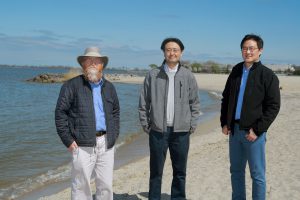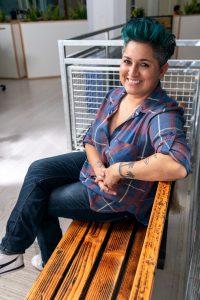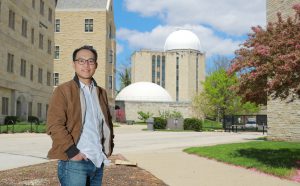Archive for May, 2021
UToledo to Host Virtual Cosmetic Formulation Camp for High School Students
Wednesday, May 26th, 2021The University of Toledo, home to the nation’s only undergraduate program in cosmetic science and formulation design, will host a virtual summer camp for high school students who wish to learn how makeup and personal care products are made.
The two-day camp is scheduled for Wednesday, June 23, and Thursday, June 24. Registration is open until Friday, June 4.
Created and led by Dr. Gabriella Baki, director of the Cosmetic Science and Formulation Design Program and associate professor of pharmaceutics in the College of Pharmacy and Pharmaceutical Sciences, the camp will offer interactive sessions and hands-on activities in which participants will learn the science behind their own health and beauty products.
The camp also will provide an overview of both the industry and UToledo’s unique baccalaureate program.
Established in 2013, the Cosmetic Science and Formulation Design Program teaches students how to design, produce, test and market cosmetics and personal care products.
“Our program is truly a mixture of science, art and business. We really focus on preparing our students for a wide variety of jobs within the industry,” Baki said. “This virtual camp is a great way to introduce high school students to the many opportunities this field provides.”
The camp also will feature presentations and virtual facility tours from several nationally known brands and major industry players, including Bath and Body Works, Estée Lauder, Wacker and Elevation Labs, as well the Society of Cosmetic Chemists.
“Since the camp is virtual, we are recruiting high school students from all states of the U.S,” Baki said. “This allows the college and the cosmetic science program to cast our net wider and spark students’ interest in chemistry, specifically cosmetic chemistry, from a broader region.”
Camp activities will include a virtual scavenger hunt and a panel of alumni of the Cosmetic Science and Formulation Design Program who will share their academic and professional experiences.
Each participant will receive a camp box that will include supplies and samples used in interactive and hands-on sessions and a camp T-shirt.
The camp registration fee is $100 per camper, with financial assistance available.
For more information about and to register for the 2021 Cosmetic Science and Formulation Design Virtual Summer Camp, visit the camp’s website.
U.S. Army Corps of Engineers Awards UToledo $1.4 Million to Develop New Techniques to Combat Toxic Algae
Wednesday, May 12th, 2021The U.S. Army Corps of Engineers awarded researchers at The University of Toledo $1.4 million to develop enhanced technology for early detection and management of harmful algal blooms, Lake Erie’s environmental menace and a worldwide problem.
Dr. Youngwoo Seo, professor of civil and environmental engineering and chemical engineering in the UToledo College of Engineering, leads the three-year project to improve water quality from the source to the tap.

Dr. Thomas Bridgeman, Dr. Youngwoo Seo and Dr. Dae-Wook Kang
Some of the technology and techniques being tested by UToledo are new to water treatment plants in the western hemisphere. Water treatment plants in northwest Ohio are collaborating on the project along with the U.S. Environmental Protection Agency, Ohio State University and Sepro Inc. Participating municipal water treatment plants include Toledo, Bowling Green, Celina and Oregon.
The project features two different parts working together:
- Advanced monitoring sensors and molecular genetic analyses to enhance early harmful algal bloom detection and real-time condition diagnostic capability; and
- Nature-inspired biological treatment methods coupled with algaecides to attack cyanobacteria and degrade toxins produced by cyanobacteria.
“We are excited that our proposed method and new techniques can make real changes for water utilities and the water quality in the lake,” Seo said. “It has great potential to be a more sustainable way to handle the cyanobacteria and their toxins.”
“Harmful algal blooms are a growing and costly problem affecting the nation,” said Dr. Jen Seiter-Moser, the U.S. Army Engineer Research and Development Center’s acting technical director for civil works, environmental engineering and sciences. “At ERDC, we benefit from collaboration with other federal, academic and industry partners. We’re looking forward to working with our UToledo partners to find solutions that can be applied regionally and then scaled up for nationwide application.”
Dr. Thomas Bridgeman, professor of ecology in the UToledo College of Natural Sciences and Mathematics and director of the UToledo Lake Erie Center, will lead the monitoring. First, he will test new instruments called fluoroprobes in the lab using algal cultures. The second stage will be to use them in Lake Erie, and finally work with water treatment plants to incorporate these instruments as part of their source water monitoring.
The sensors can detect the health, or physiological condition, of the cyanobacteria — whether the cyanobacterial cells are becoming fragile and leaky, releasing their toxins into the water — along with the concentration of cyanobacteria and how blooms react to water treatment chemicals.
“These monitoring sensors made by the German company bbe Moldaenke are capable of easily detecting when cyanobacterial cells are starting to rupture, which could be a powerful tool for water utility managers to respond to and minimize toxin release,” Bridgeman said.
Dr. Dae-Wook Kang, assistant professor of civil and environmental engineering in the UToledo College of Engineering, will lead a molecular approach to develop a robust detection method. He will obtain rich microbial DNA, RNA and metabolomic information from samples, which can be an indicator of cell metabolism, and try to better identify the biomarker for the harmful algal bloom.
“Harmful algal blooms are outcomes of a complex network between cyanobacteria and neighboring competitors such as cyanophages and eukaryotes. By integrating these dynamic microbiome data together with sensor and water chemical data, we aim to develop an early and rapid detection tool of harmful algal blooms,” Kang said.
“In the lake we have harmful algal blooms but also other bacteria that interact with each other,” Seo said. “Sometimes cyanobacteria don’t produce high concentrations of toxins even when the bloom is large. Sometimes we have a small bloom, but have high concentrations of toxins.”
Kang is using molecular techniques to decipher how the water conditions affect algal blooms and the bloom conditions and how other microorganisms in the water interact with cyanobacteria and impact bloom conditions.
That analysis will help better understand what triggers the toxin gene production of cyanobacteria.
Seo is focused on mitigation and the treatment method for toxin removal. His lab is working on biological degradation of cyanobacteria and their toxins using the naturally occurring bacteria and viruses from the lake and NSF-approved chemical treatments.
“Once we detect the harmful algal bloom, we will try to reduce the algal bloom in early stages, using bacteria and algicide treatments of the cyanobacteria and their toxin directly in the lake to control the toxin from spreading,” Seo said. “We are collaborating with microbiologists at the Ohio State University who have isolated different viruses of the cyanobacteria, and we are evaluating their effectiveness to control the harmful algal bloom.”
Seo says the goal is to introduce new techniques to mitigate the harmful algal blooms through early detection and work with water treatment plants to optimize and improve their treatment methods.
Reminder: Class of 2021 Commencement to be Celebrated in Person May 8
Wednesday, May 5th, 2021The Class of 2021 will walk across the stage in the Glass Bowl to celebrate receiving their degrees this weekend.
The University of Toledo will hold multiple in-person commencement ceremonies to celebrate graduates in person while also adhering to COVID-19 safety protocols.
UToledo spring commencement ceremonies will be held at 10 a.m. and 3 p.m. Saturday, May 8, in the Glass Bowl.
The 10 a.m. ceremony recognizes graduates from the colleges of Engineering; Health and Human Services; Nursing; and University College.
The 3 p.m. ceremony recognizes graduates from the colleges of Arts and Letters; the John B. and Lillian E. Neff College of Business and Innovation; Judith Herb College of Education; and Natural Sciences and Mathematics.
The commencement events commemorate 1,964 candidates for bachelor’s degrees, 703 candidates for master’s degrees, 52 candidates for associate’s degrees, 12 candidates for educational specialist and 45 candidates for graduate certificates.
Plus, 302 graduates from the Class of 2020 who earned their degrees during the coronavirus pandemic are scheduled to return to campus to participate in the May ceremonies.
Graduating students are split into groups for the separate ceremonies and guests are limited with tickets required for admission. All attendees will be required to wear face masks and keep at least 6 feet from others not in their household.
“We’re excited to have the opportunity to provide our graduates with an in-person celebration,” UToledo President Gregory Postel said. “Our Rockets continue to demonstrate focus, perseverance and strength through their academic success, despite the challenges presented by COVID-19 during the last year. We look forward to celebrating the Class of 2021’s achievements and resilience at our in-person spring commencement ceremonies.”
The ceremonies also will be streamed live online at utoledo.edu/commencement.
UToledo alumna Irma Olguin, Jr. will remotely deliver the keynote address at the ceremonies.

Irma Olguin, Jr.
Olguin is co-founder and chief executive officer of Bitwise Industries in Fresno, Calif. She graduated in 2004 from the UToledo College of Engineering with a bachelor’s degree in computer science and engineering and went on to blaze a trail of inclusivity for women and minorities in the tech industry.
In March, Bitwise Industries announced it is investing in Toledo. Olguin’s tech company plans to open a branch in in the Jefferson Center building, Toledo’s historic former post office, to provide paid apprenticeships to students from diverse and underserved communities to learn tech skills.
“Ms. Olguin is an outstanding UToledo alumna making an incredible impact on the world,” said Dr. Karen Bjorkman, provost and executive vice president for academic affairs. “We are pleased to welcome the entrepreneur as our commencement speaker to inspire our newest alumni as they receive their degrees.”
The College of Pharmacy and Pharmaceutical Sciences held its separate in-person ceremony last weekend.
College of Law Commencement is 10 a.m. Saturday, May 15, in Savage Arena.
College of Medicine and Life Sciences Commencement is 3 p.m. Friday, May 21, in Savage Arena.
And those receiving doctoral degrees will have the opportunity to participate in a separate hooding ceremony at 6 p.m. Friday, May 7, in Savage Arena.
NASA Selects Projects Led by UToledo Astronomers for James Webb Space Telescope’s First Observing Cycle
Tuesday, May 4th, 2021Astronomers at The University of Toledo were selected by NASA to lead five of the first research projects on the James Webb Space Telescope, a new infrared telescope scheduled to launch in October.
One of the projects is led by a UToledo graduate student.
“While it’s exciting for our program to have five accepted proposals in the first observing cycle of this highly competitive, next-generation space telescope, the real thrill came from Ph.D. Student Thomas Lai’s success with his proposal targeting a unique starburst galaxy,” said Dr. J.D. Smith, director of UToledo Ritter Astrophysical Research Center and professor of astronomy.
Students lead 8.7% of selected proposals, according to the Space Telescope Science Institute.

Thomas Lai
Lai, who is scheduled to graduate in May with a doctorate in physics and astronomy, is leading an international team of 10 other researchers on a project titled “How Do the Small Survive.” They will observe a galaxy called II Zw 40 that is roughly 33 million light years away from Earth and hosts one of the most intensive star-forming regions in the local universe.
“I feel extremely fortunate to have the opportunity to use this flagship NASA space observatory,” Lai said. “Using the power of the James Webb Space Telescope we will be able to study how dust behaves near the sites of intense star formation with unprecedented high spatial resolution. Ultimately, we would like to answer the questions on why and how small dust grains survive in the universe despite strong radiation fields produced by newly formed young stars.”
UToledo is ranked No. 6 among all institutions worldwide in terms of successful proposals for the first cycle of the James Webb Space Telescope.
From more than 1,000 submitted proposals, NASA selected 286 projects to address a wide variety of science areas. Proposals are split into eight different categories – planets, stars and galaxies, for example.
“Nearly 20% of the star time is going to UToledo because of our large programs in that category,” said Dr. Michael Cushing, professor of physics and astronomy and director of UToledo Ritter Planetarium. “Of the 740 hours awarded in the category of Stellar Physics and Stellar Types, 140 hours went to UToledo.”
Cushing is leading a project titled, “Bolometric Luminosities of Cool Brown Dwarfs: The Key to Their Effective Temperatures and the Mass Function.”
“The initial year of Webb’s observations will provide the first opportunity for a diverse range of scientists around the world to observe particular targets with NASA’s next great space observatory,” said Dr. Thomas Zurbuchen, associate administrator for the Science Mission Directorate at NASA. “The amazing science that will be shared with the global community will be audacious and profound.”
UToledo-led projects also include:
- “Vanishing Act: PAHs and Heavy Element Abundance in M101” by Smith;
- “Come Out, Come Out, Wherever You Are: Seeking All the Massive Young Clusters Hidden in the Antennae” by Dr. Rupali Chandar, professor of astronomy; and
- “Investigating Protostellar Accretion Across the Mass Spectrum” by Dr. Tom Megeath, professor of physics and astronomy.
“The James Webb Space Telescope is going to completely transform our understanding of galaxies, star formation and ultra-cool stars, and UToledo astrophysicists have real strengths in these research areas,” Smith said. “Our group is also deeply experienced in exploiting JWST’s long infrared wavelengths of light to study the cold, dust-veiled universe. Now all our eyes are on the space telescope’s Halloween launch later this year.”
Webb will begin observing the universe in 2022 after the spacecraft unfolds, travels a million miles and checks the functioning of all of its instruments.
“We are opening the infrared treasure chest, and surprises are guaranteed,” said Dr. John C. Mather, senior project scientist for the Webb mission and senior astrophysicist at NASA’s Goddard Space Flight Center in Greenbelt, Md. “How did the universe make galaxies, stars, black holes and planets, and our own very special little Earth? I don’t know yet, but we are getting closer every day.”
General observer time with Webb is extremely competitive. As a result, the proposal selection process conducted by the Telescope Allocation Committee is both rigorous and meticulous. The committee was comprised of nearly 200 members of the worldwide astronomical community who were assigned to 19 different panels covering broad scientific topics.
Using dual-anonymous review, where the identities of the proposing investigator and team were concealed, the scientific merit of each proposal was evaluated and ranked. The final, ranked list of selected proposals was presented to the Space Telescope Science Institute’s Director, Dr. Kenneth Sembach, for review and approval.
“The first observing cycle with a new observatory is always special, especially one as powerful and highly anticipated as Webb. We had an incredibly interesting couple of weeks of intense proposal reviews during which the reviewers did a great job of sorting through and ranking all the possible science cases proposed. I commend them for their hard work, especially under pandemic conditions,” said Sembach. “I’m very pleased to be able to approve such a strong science program for the observatory. These observations are going to provide stunning views of the universe and lead us in new investigative directions that will set the stage for decades of research.”

